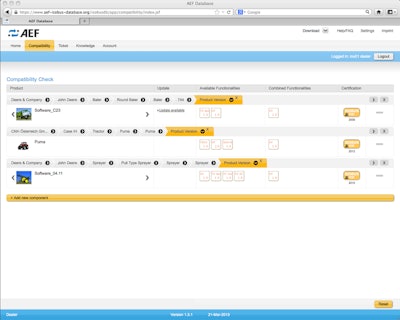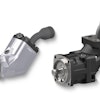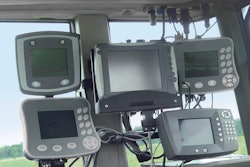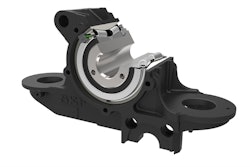
Today, the most important innovation driver for agricultural technology is electronics. In particular, ISOBUS (or ISO 11783), which has become a global standard, is the prerequisite for the trend toward networked system solutions. Indeed, for system compatibility, it is essential what the Universal Terminal and the implement are capable of performing – both separately and together.
In the past this was often unclear. To increase transparency, the Agricultural Industry Electronics Foundation (AEF) has defined Functionalities which now also provide the basis for both the certification of ISOBUS products and for an ISOBUS database.
New AEF ISOBUS certification and new label
The advancement of the ISO 11783 standard and the AEF Guidelines has added new AEF Functionalities to the Universal Terminal (UT), such as auxiliaries (AUX) and section control (TC-SC). The AEF has developed a communication concept based on these functionalities, as well as a new ISOBUS label which provides more information, made possible thanks to the new AEF-developed Conformance Test for ISOBUS products including their certification. This allows the product to conform to the ISO 11783 standard as well as let the user know which functionalities the device supports.
Each element of ISOBUS functionality can be explained as an independent module on the ISOBUS. Only the functionalities which are available in all of the components involved are mutually compatible, and only then can the desired plug-and-play be used to its full effect.
Universal Terminal
The option to operate an ISOBUS device using any terminal and to operate many different devices using a single terminal. In this way, one ISOBUS Universal Terminal can replace the need for a multitude of attachment-specific terminals on the tractor. Each one can connect with any other, so long as they support ISOBUS. All other ISOBUS attachments can be operated using a single terminal, regardless of whether it was produced by the tractor manufacturer or the attachment manufacturer.
Read more on the Universal Terminal and AEF's efforts.
Auxiliary control refers to the additional operating controls, such as a joystick, which make it simpler to operate complex equipment; or the possibility to control functions on the implement using an additional operating control. There is an old version and a new version, but these are not compatible with each other. This means that implements which are certified to AUX-N (auxiliary control -new) cannot be operated with implements certified to AUX-O (auxiliary control - old), and vice versa.
The basic task controller manages the documentation of total values, which are useful with regard to the work performed. The implement makes these values available, and the data is exchanged between the farm management Information system (FMIS) and Task Controller (TC-BAS) in the ISO XML data format. This means that tasks can be easily imported into the Task Controller and the completed documentation can be exported again afterwards.
A geo-based task controller offers the additional option to collect location-specific data or to plan location-specific tasks, by using application maps, for example. And a section control task controller handles the automatic switching of partial widths, for example for crop-protection sprayers, fertilizer spreaders and precision seeding machines, depending on GPS position and the desired degree of overlap. Section Control can deliver higher yields while saving 5 to 10% of material inputs.
The AEF certification label
The aim of the new AEF certification label is to communicate as much information as possible about the ISOBUS product and its specific software. The AEF certification logo identifies ISOBUS components (agricultural engineering products) which conform to the ISO 11783 standard and to the supplementary AEF Guidelines. The product will have successfully completed the AEF certification process. Further information can be found in the AEF database at www.aef-isobus-database.org.
The label provides “personalized” information about the functionalities that the specific product can offer. Functionalities are indicated by small squares and abbreviations. If you want to use several components in conjunction with one ISOBUS system, the “lowest common denominator” of functionalities available in both components can be determined by comparing the markings in the logo.
The AEF ISOBUS database...
Who is responsible when something is incompatible—the tractor manufacturer or the device manufacturer? How can I find an implement for my ISOBUS tractor which is also fully ISOBUS-compatible, and with which I can benefit from significant advantages? Is the implement that I already own ISOBUS-certified and compatible with the new ISOBUS tractor that I want to buy? And if so, which functionalities can I use with both of them?
These and many other questions will be answered by the AEF ISOBUS database, set to be launched later this year, at www.aef-isobus-database.org. The database contains relevant information about all machines and devices which have been ISOBUS-certified thus far. A user can configure his tractor/implement combination and immediately see whether the selected combination is compatible and with which common functionalities it is equipped. The user can even compare alternatives. If a device cannot be found in the database, it is not certified.
For the dealer, the database makes advising customers easier on the one hand, and on the other, it speeds up troubleshooting through customer service. This can appreciably shorten downtimes.
Lastly, OEMs can collect reports about device problems which remain available in the database as ISOBUS "Knowledge." These can also be used by the customer service team in the dealership to diagnose and find solutions to problems on-site more quickly. The database is continually and automatically maintained. This is because determining the conformity of machines and implements with the ISOBUS standard, and the related certification, is also carried out by independent, regional ISOBUS Test Laboratories. In addition, a Conformance Test Tool (CT) that is available via the database facilitates and accelerates product development within AEF member companies. The CT can be downloaded via the database in order to carry out internal interim tests.
To upload officially certified products in the database, the manufacturer must purchase a license from AEF. A license must also be purchased in order to use the CT.
Ultimately the AEF ISOBUS database supports the complete agricultural public (users, dealers and manufacturers) in using the new, worldwide ISOBUS standard.
For more detailed information on compatibility and functionalities, refer to the new AEF ISOBUS Conformance Test and independent certification, as well as the AEF ISOBUS database, from which all data can be retrieved. This is currently being uploaded and tested by manufacturers, but should be made available to the wider agricultural public by the end of the year.
An informative presentation can be downloaded from the homepage at www.aef-isobus-database.org.
Since 2008, the “round table” for all manufacturers worldwide has been AEF, which is continuing to formulate the ISOBUS standard. The organization has some 150 members today, most of them OEMs. The growing number shows the need for standardization, and the sharing of information is well received by the industry.


















